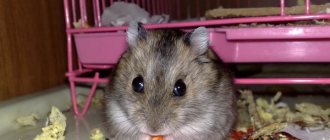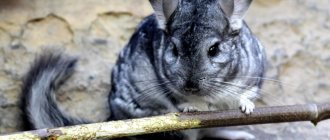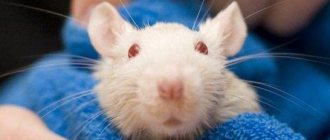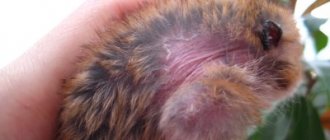Be careful when choosing your pet. If, after seeing a wet tail on a hamster that is put up for sale, you do not refuse to buy, this will lead to tragedy. The seller may convince you that the Homa got dirty in the cage, or that the diarrhea was caused by fresh grass. Neither the rare color nor the persuasion of children should influence the decision: the disease of hamsters, which is called “wet tail,” is extremely contagious and often ends in the death of the animal.
Additional symptoms of a wet tail
The danger in hamsters lies in the long incubation period - up to 14 days. At this time, the pet continues to lead a normal life without any signs of illness, but he himself begins to infect other individuals.
After this time, the animal’s entire rear part, including the tail, becomes wet. Added to this are other serious symptoms:
Liquid feces The pet stains the entire cage with watery feces with a fetid odor; their color can be black or brown with impurities of blood.
Loss of appetite. The hamster refuses to eat and drinks little. When you try to force-feed your pet liquid food through a syringe, stomach upset increases.
Decreased activity. A sick animal moves little, sleeps almost all the time and does not react to stimuli. If he tries to walk around the cage, his paws tremble and move in different directions.
Discharge. A slimy transparent secretion flows from the nose, eyes and genitals.
Severe diarrhea in a hamster will lead to dehydration. To confirm, the owner can gently pinch a fold of the pet's skin between their fingers. It will not immediately smooth out, but will remain convex for some time.
How can you tell if your pet is sick?
If your pet is sick, he may experience the following changes:
- apathy and lethargy;
- no appetite;
- the wool has become tangled, has lost its shine, is falling out or matted;
- there is discharge from the eyes and nose;
- pollution near the anus;
- constipation and gastrointestinal disorders;
- severe nervousness and aggression of the animal;
- temperature.
Since hamsters have a very fast metabolism, the first symptoms and signs of illness are immediately visible. At the same time, the deterioration of the condition also occurs quickly, which is why it is very important to provide the pet with the necessary help and treatment in a timely manner.
Pathogens
The cause of the appearance of a wet tail and other accompanying symptoms is the penetration of gram-negative bacteria Campylobacter and Lawsonia intracellularis into the hamster's body.
In veterinary medicine, the disease caused by these bacteria is called proliferative ileitis. The main routes of transmission are contaminated food and feces. However, not all infected individuals show symptoms.
A pet with a strong immune system can cope with pathogenic bacteria on its own, quickly eliminating the consequences of their vital activity. Weak individuals risk dying from body intoxication and dehydration. This outcome also awaits hamsters who are in a cramped or overcrowded cage without proper hygienic care.
Diagnostics
To make a diagnosis, the veterinarian will base the diagnosis on a combination of all the signs of a wet tail. A clear clinical picture makes it possible to prescribe treatment.
If the breeder has a large number of individuals, then you can try to make an accurate diagnosis using laboratory tests. This is necessary not only to save one pet, but also to take measures to protect other individuals.
For diagnostic purposes, secretions - feces, saliva - are collected from the infected animal. The resulting material is placed in a nutrient medium and, after the bacteria multiply, it is studied under a microscope.
Thus, Campylobacter can be detected, whereas Lawsonia intracellularis, due to its inability to live outside the cells of the host organism, cannot be detected.
To collect statistical data, the veterinarian may conduct tests for the presence of antibodies to gram-negative bacteria at the onset of the disease and after recovery. For the same purpose, the body of a hamster after death is studied through an autopsy.
The activity of bacteria leads to thickening and inflammation of the small intestine and enlargement of the lymph nodes of the abdominal cavity. In the intestines there is a viscous yellow liquid interspersed with blood.
Treatment
The regimen is prescribed by a veterinarian after determining the clinical manifestations. Most often used:
Antibiotics. Baytril – 0.5% solution for injection. The active ingredient is enrofloxacin. In the instructions for the drug, the dosage is 0.4 ml per 1 kg of weight.
It is impossible to calculate it for a hamster yourself. The course of treatment is 7-14 days.
Probiotics. Emprobio, Bifitrilak, Lactoferon. The preparations contain beneficial bacteria and their metabolic products. They are necessary to restore the balance of intestinal microflora and stimulate the production of antibodies.
The dose for an individual weighing 45-50 g is 0.1 ml. Probiotics should be given to the animal in diluted form - food, pure liquid.
Solutions for correcting water balance disorders. A dehydrated individual requires hydration therapy. It is carried out by a veterinarian, giving intra-abdominal and subcutaneous injections with Ringer's lactate, saline and glucose.
To generally strengthen and maintain body functions, the hamster is added to the diet with ascorbic acid and Catozal, which accelerates metabolic processes at the cellular level.
Features of care
At the first suspicion of infection, a sick hamster must be separated from other individuals. They should also be temporarily moved to a separate cage, and the previous one should be disinfected. Any chlorine-containing solution is suitable for this purpose.
After treatment, the rodents' house should be thoroughly rinsed with clean water. All installed equipment – toys, feeders, drinking bowls – also require disinfection.
The cage of a sick individual should always be dry and warm. The temperature in the room is 21-26°C without drafts. Carry out daily cleaning with changing bedding.
All hygiene measures must be carried out with gloves, since bacteria can pass through the owner’s hands to healthy animals. During the period of treatment and recovery, vegetables and fruits should be excluded from the hamster’s diet. It is better to offer your pet grain food - wheat, oats, rye.
Prevention
To prevent infection of the hamster family with proliferative ileitis, the following rules should be followed:
- A new individual must be quarantined for 14 days.
- Buy a hamster only from trusted breeders.
- Adjust the diet based on the advice of your veterinarian.
- Choose natural food without chemical additives.
- Clean the cage every day. Pet hygiene procedures – once a week.
- Disinfection of housing and equipment - every 14 days.
- Eliminate stressful situations and fear of the animal.
Some breeders add antibiotics to the water for preventive purposes. But this is absolutely impossible to do, because such drugs do not protect against infection, but will only distort the clinical picture of the disease.
In addition, antibiotics disrupt the gastrointestinal tract, which in itself can lead to a wet tail in your pet due to diarrhea.
Baldness
Baldness (alopecia) is a consequence of vitamin deficiency. Often occurs in winter due to prolonged feeding of dry food. In this case, no medical procedures are necessary. Baldness goes away quickly when the animal begins to eat green food. Therefore, caring owners should prepare green complementary foods for the winter and store them in the freezer.
Hamsters go bald for various reasons. The most likely is a lack of vitamins.
Sometimes owners are concerned about dark spots on the sides of the hamster's skin. But this is not a disease. The lateral glands are sometimes marked with excessive pigmentation, and this does not affect the health of the pet.
Which breeds are most susceptible to this disease?
The phenomenon is typical for all breeds of rodents due to the special structure of the gastrointestinal tract. But according to statistics, Syrian hamsters have a slightly higher percentage of infection due to their long hair, which is more difficult to clean from contamination.
In this case, individuals under the age of 12 weeks most often become ill. They have not yet sufficiently acquired the skill of cleaning their own wool and do not do it very carefully. This is also typical for older hamsters; in their case, the daily washing ritual takes a lot of energy.
Bites
By nature, hamsters are loners. But often breeders keep several individuals in one spacious cage. When sorting out relationships, hamsters can fight and bite each other. Wounds quickly become infected, so they need to be quickly treated with a disinfectant and, if necessary, antibiotic powder applied.
Hamsters live on average 3 years. Diseases most often threaten them in the first months of life and at an advanced age. Owners should remember that a lot depends on their attention in matters of pet health.
The disease is often triggered by stress. Stress can be caused by:
- the appearance of a new neighbor in the animal’s house;
- overcrowding in the cage;
- relocations and travel;
- violation of the usual routine;
- changing the usual place of the cell.
If you pay enough attention to your hamster and take responsible care of his hygiene and comfort, he will delight you with good health and a cheerful disposition.
Diseases of Djungarian hamsters cannot be separated into a separate group, since they are susceptible to all the same problems of different breeds. With good care, the animal can live a long life without any ailments, but this does not always happen, and the owner must be ready to help the pet. The main distinguishing feature of dzhungariks is their tiny size and associated body features.
Since it can be difficult to find a veterinarian who specializes in small rodents, the owner should at least have a general idea of what hamsters suffer from and how to treat them.
Fast Metabolism
Due to the intensive metabolism, some diseases in dzhungariks occur very quickly. may die from diarrhea within 1-2 days.
Fragile nervous system
Djungarians are susceptible to stress. Irritating factors (, noise,) themselves can lead to illness.
Nervousness leads to disturbances in stool, coat, itching and alopecia.
It should be taken into account that transportation for an animal can be a stress factor. If your hamster gets sick, it is necessary to visit a veterinary clinic, but subsequent procedures are best done at home. The doctor can show how to secure the baby in a safe way and perform manipulations.
Genetic predisposition
Some diseases occur much more often in dwarf hamsters than in other hamsters. This is primarily obesity
and
diabetes mellitus
. Campbell's hamsters are initially predisposed to diabetes, but they are so similar to Djungarian hamsters that the two species often interbreed. The owner cannot be sure whether his pet is a mixed breed.
Hereditary diabetes occurs as early as 2-4 months of age.
The difference between wet tail and diarrhea – when to sound the alarm?
An inexperienced breeder most often fails to figure out in time what happened to his pet. Only 2-3 days pass from the appearance of a “wet tail” to the death of the rodent.
Therefore, it is very important to monitor your patients and understand what is happening to their health.
So, if a hamster has a wet backside, and he is actively playing, cleaning his fur, and eating, then most likely it is just diarrhea. But the reasons for its appearance should also be found out; maybe the food is not suitable for the animal or there is an excess of watery food in the diet.
You should go for a consultation with a veterinarian and begin active treatment if the hamster behaves aggressively on the first day of the “wet tail”. At the same time, such activity sharply changes to passivity, and he stops responding to any attempts to stir him up.
The animal mostly sleeps restlessly, its fur looks unkempt.
Traditional methods of treatment
Traditional methods can be quite effective in treating human diseases, but with animals the situation is different. Not all recipes that help people are suitable for animals, so you need to be very careful. If you are sick, it is better to consult a veterinarian, but if this is not possible, then you can try using a decoction of grain crops (barley and oats are most often used). This remedy will help stop the diarrhea, and then there should be enough time to take the patient to a veterinary clinic. Traditional methods are aimed at eliminating symptoms and gaining time, and not at fighting the cause.
Other problems that lead to wet tail
There are many factors that cause the fur around a rodent's anus to become wet. The main ones.
Poor nutrition
Hamsters' favorite treats are fruits and greens. They will rarely refuse an extra piece of apple, pear or banana.
But their excess in the diet will lead to diarrhea. Therefore, fruits should become a delicacy for rodents as a reward.
Poor hygiene
Lack of proper care undermines the pet's gastrointestinal tract and weakens its immunity. The hamster is constantly in contact with dirty and wet sawdust, drinking bowls and food bowls, and a place to rest.
If the cage is not cleaned for a long time, a large amount of dried food and feces accumulates at its bottom.
Gastrointestinal problems
Wet tail appears in hamsters even without bacterial infection. This occurs due to an imbalance of intestinal microflora, when one type of microorganism predominates over another. Once the balance between them is restored, the pet’s health will improve.
Stress
Representatives of the Khomyakov family tend to get scared and fall into melancholy. They experience stress after parting with their mother, moving to a new cage, or living with a large number of relatives. Even loud noises will cause stomach upset.
Gynecological problems
In young females after childbirth and old individuals, pathologies in the reproductive system, in addition to a wet tail, are accompanied by:
- bleeding;
- brown-yellow discharge with a strong unpleasant odor;
- bloating;
- protrusion of the vagina outward.
The listed symptoms may be a consequence of the presence of tumors and infections in the genitals or injury during childbirth.
Urinary tract infections
Old hamsters are susceptible to infection of the urinary system by pathogenic and fungus-like bacteria.
They experience a change in urine, it becomes yellow-green with a putrid odor and interspersed with blood clots. A sick hamster drinks a lot and relieves itself, gets tired quickly, and its fur is disheveled.
The prognosis for the recovery of a pet with a wet tail largely depends on how quickly the owner gets to the veterinarian. After all, proliferative ileitis is a disease of rapid development, and delay will lead to the death of a cute rodent. The sooner treatment begins, the greater the chance of saving your pet’s life.
Great article 1
Djungarian hamster: contagious diseases
When kept in isolation and infected
They occur extremely rarely in hamsters.
The animal can become infected with food, bedding, or from humans - which is why it is so important to wash fruits, vegetables and hands before contacting the rodent. treatment for viral diseases
, and if the doctor determines
a bacterial infection
, antibiotics are used.
Everyone knows that hamsters are very unpretentious pets. But also do not forget that, like any creature, a hamster can get sick and will need your help in treatment. Let's talk now about the main ailments the owner of these pets may encounter, why they occur, as well as how to recognize the disease at an early stage and what to do. The video will help us understand some points in more detail.
[Hide]











